The Dubai Metro Map: An In-Depth Public Transit Guide
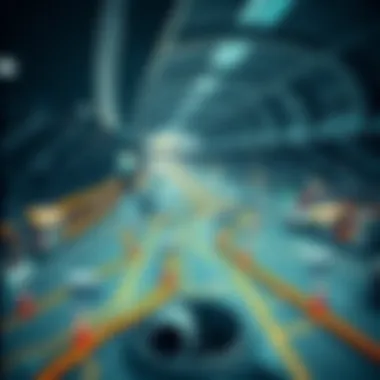
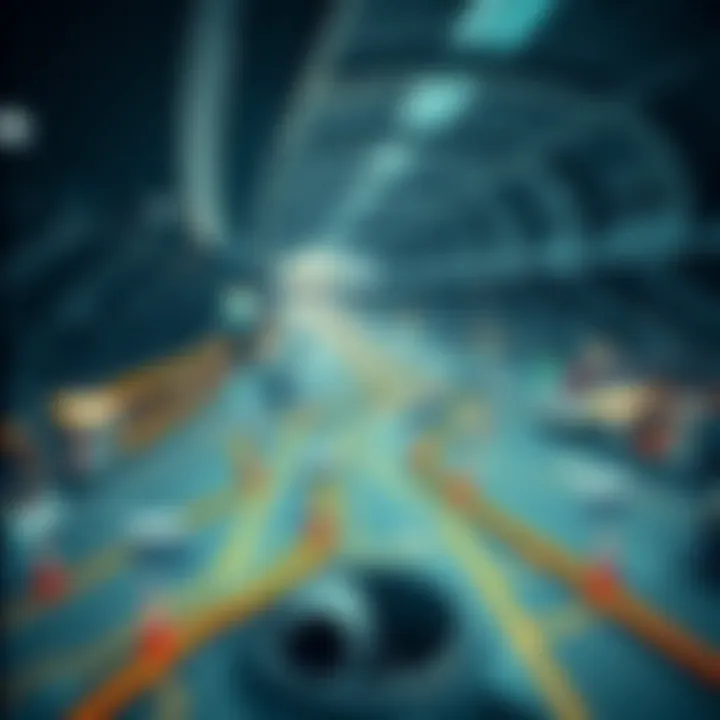
Intro
Understanding a city’s public transportation system is like peering into its very soul. In a bustling metropolis like Dubai, where the sands of time meet modernity, the Dubai Metro serves as a lifeline. This comprehensive guide not only maps out the metro’s vast network but also provides insights into how it plays a crucial role in shaping the city’s infrastructure and daily life.
With a network stretching over 90 kilometers, the Dubai Metro is known for its punctuality, cleanliness, and state-of-the-art technology. It’s a marvel of engineering that connects diverse neighborhoods, commercial hubs, and tourist hotspots. Whether you are a first-time visitor or a long-time resident, knowing how to navigate this transit system can enhance your experience in the city and save you time.
In the sections that follow, we will explore the operational structure of the metro, emphasizing station features, fare systems, and interactions with other transit services. Understanding these components will benefit not just travelers but investors and city planners who wish to tap into the opportunities that are spurred by efficient transportation networks. Let’s dive deeper into the workings of the Dubai Metro.
Prologue to Dubai Metro
Understanding the Dubai Metro system is akin to grasping the pulse of one of the fastest-growing cities in the world. It’s not just about getting from point A to point B; it’s about the lifeblood of the city, intertwining urban mobility with daily life in a region renowned for its rapid development. With its sophisticated design and cutting-edge technology, the metro encapsulates the essence of Dubai's commitment to futuristic infrastructure.
Historical Background
The inception of the Dubai Metro traces back to the early 2000s, a period when Dubai was transforming itself from a trading port into a global metropolis. In 2006, the first phase was launched, setting a precedent for modern public transport in the region. The inspiration behind its construction was not only to address the burgeoning traffic congestion but also to support the UAE's vision of sustainability.
The initial project faced numerous challenges, primarily due to its ambition and scope. However, the government’s determination paid off when the Red Line was inaugurated in September 2009, marking a new chapter in urban public transport. By 2011, the Green Line became operational, enhancing connectivity and accessibility to various districts. This significant investment underscored the desire to create a more structured urban environment.
Overall Structure of the System
The Dubai Metro comprises two main lines: the Red Line and the Green Line. Together, they stretch across the metropolis, offering over 70 kilometers of purely automated travel. The system is designed to cater to not just tourists but also the local population, effectively encouraging public transport usage.
Red Line: With a length of approximately 52 kilometers, the Red Line connects key areas such as Burj Khalifa, Dubai Mall, and Jebel Ali, providing easy access to some of the most significant landmarks in the city.
Green Line: The Green Line, slightly shorter at around 23 kilometers, primarily serves the older parts of Dubai, catering to communities that have been part of its history for decades.
The overall structure includes underground, elevated, and at-grade sections, showcasing architectural finesse that complements the city's skyline.
"The Dubai Metro isn't just a mode of transport; it's a catalyst for social and economic transformation in the city."
In addition to the lines, there are around 47 stations, each with unique features and designs that reflect the cultural ethos of Dubai. The system is further supported by a connection to other public transport modes, such as buses, trams, and water taxis, ensuring a seamless commuting experience. This thoughtful integration enhances the overall public transport ecosystem, making it a cornerstone for Dubai's urban planning and development.
As we delve deeper into the operational aspects of the Dubai Metro, understanding its historical context and structural design lays the foundation for appreciating how it functions effectively within the city's broader transportation network.
Operational Details
Understanding the operational details of the Dubai Metro is crucial to appreciating its role in facilitating urban transportation. This section delves into the structure and characteristics of the metro lines, with a particular focus on their unique attributes and the service they provide. Examining these elements not only gives insight into the system's efficiency but also highlights how it meets the daily needs of commuters in a bustling metropolis.
Metro Lines Overview
Red Line
The Red Line is a backbone of the Dubai Metro system. Stretching from Rashidiya to UAE Exchange, it covers approximately 52 kilometers. This line is significant because it connects key zones like the Dubai International Airport, Downtown Dubai, and Jebel Ali. One key characteristic of the Red Line is its ability to link major hubs, making it a pivotal choice for both residents and tourists alike. For instance, the proximity to the Burj Khalifa and the Dubai Mall makes it a magnet for visitors seeking leisure activities.
The unique feature of the Red Line is its accessibility to various areas of commercial and social activity. It frequently hosts the highest ridership rates compared to other lines, which serves as evidence of its popularity. However, during peak hours, the Red Line can become crowded, presenting a challenge for commuters.
Green Line
The Green Line runs from Dubai Creek to the Dubai Knowledge Village, covering about 23 kilometers. It is particularly vital as it complements the Red Line, offering a crucial link for areas such as Al Quoz and the Dubai Healthcare City. One of the standout characteristics of this line is its focus on connecting educational and healthcare institutions, which is beneficial for students and professionals alike.
A notable advantage of the Green Line is its relatively lesser foot traffic compared to the Red Line, offering a quieter ride much of the time. However, it also has its drawbacks. Areas served by the Green Line may not be as densely populated, leading to lower overall ridership.
Future Extensions
Dubai's vision for its metro system includes ambitious plans for future extensions. With ongoing developments aiming to extend both the Red and Green Lines, the impact of these future extensions is expected to be significant. These will not only enhance connectivity but also support the shifting urban landscape and burgeoning population growth.
The unique feature of the planned expansions is their strategic positioning to include more residential and commercial areas. Such developments are aligned with Dubai's broader urban planning strategies. As these extensions roll out, they promise to alleviate congestion on existing lines, ensuring smoother commutes. Nonetheless, there are concerns about construction times and how they might temporarily affect current riders.
Service Frequency and Timing
Service frequency is another pivotal aspect of the Dubai Metro’s operations. The metro trains run regularly, typically every 2-7 minutes during peak hours, while the intervals may stretch up to 10-15 minutes during off-peak times. This well-planned schedule allows commuters to rely on the metro as a timely and efficient mode of transportation. The operational hours from 5:00 AM to midnight cater well to both morning professionals and night owls.
"The Dubai Metro operates seamlessly, accommodating the dynamic needs of a modern urban population."
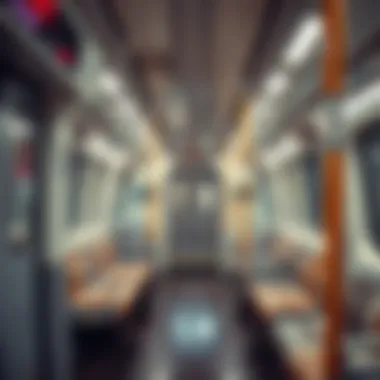
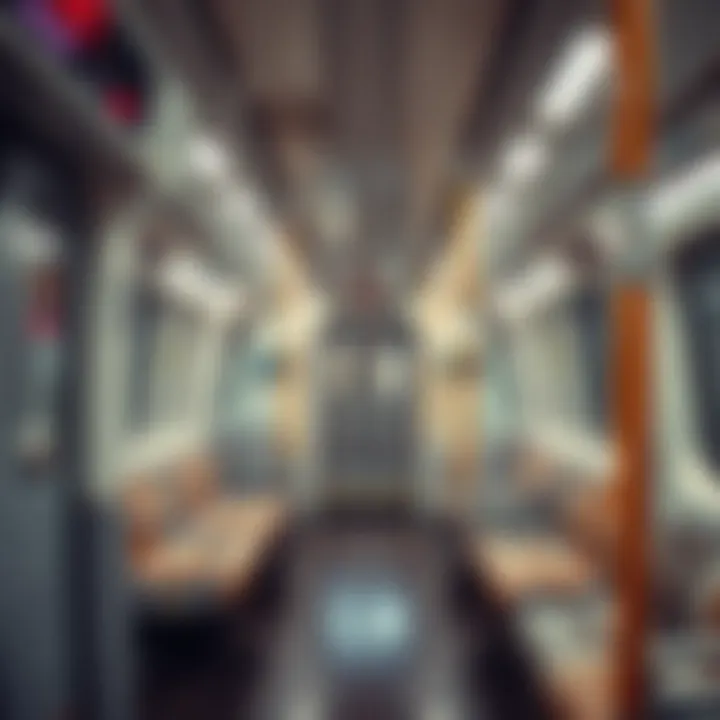
This focus on efficiency can directly enhance user satisfaction, ensuring that individuals can navigate the city’s vast recreational and business districts with relative ease. The reliance on the metro as a primary mode of transport continues to grow, which indicates a well-networked public transport system that is adaptable and forward-looking.
By addressing the operational details, one can appreciate the interplay of these various components in crafting a public transportation experience that is both accessible and in tune with growing urban demands.
Station Guide
Understanding the station guide of the Dubai Metro is paramount for anyone looking to navigate this extensive public transportation system smoothly. This section sheds light on the key stations, their unique characteristics, and the accessibility features that make commuting not just convenient but adaptable for everyone. By knowing the ins and outs of major stations, travelers, investors, and residents can strategize their journeys, tap into available resources, and gain a better appreciation of the urban environment.
Key Stations and Their Features
Burj Khalifa Station
The Burj Khalifa Station stands tall as one of the most recognizable transit points in Dubai. Located underneath the world's tallest building, this station offers direct access to the magnificent Burj Khalifa and the adjacent Dubai Mall. The primary appeal of Burj Khalifa Station lies in its strategic location, making it a sought-after stop for tourists and residents alike.
One of the unique features of Burj Khalifa Station is the seamless connectivity it provides, linking commuters to both the metro and various amenities in the vicinity. With high volumes of foot traffic, it’s not just beneficial for commuters but also for retail spaces nearby. However, the heavy footfall can sometimes lead to crowding, especially during peak tourist seasons, which may pose a minor inconvenience to everyday users.
Dubai Mall Station
Sharing the limelight with Burj Khalifa, the Dubai Mall Station is a powerhouse of connectivity. It offers access to one of the largest shopping malls in the world, making it a popular choice for shoppers and entertainment seekers. The station features expansive walkways leading directly to the mall, allowing for an effortless transition from transit to retail therapy.
What sets Dubai Mall Station apart is its multifunctional design. Not only does it cater to those traveling to the mall, but it also connects with major public attractions such as the Dubai Fountain and various art galleries in the vicinity. One advantage here is the opportunity for entertainment enthusiasts to enjoy numerous activities without needing to venture far, but the station can also become quite congested during weekends and holidays, which can make it less than ideal for quick trips.
Airport Terminal Stations
The Airport Terminal Stations play a critical role in the overall functionality of the Dubai Metro system. With two dedicated stations – one for Terminal 1 and the other for Terminal 3 – they are vital for travelers coming in and going out of the bustling city. These stations are designed with modern comforts in mind, ensuring ease of access for passengers with varied needs.
A key characteristic of the Airport Terminal Stations is their 24-hour service, making them invaluable for late-night or early-morning flights. One significant advantage of these stations is the rapid transfer between flights and city transit, allowing passengers more flexibility in planning their journeys. However, they can occasionally be a bit challenging to navigate for first-time users due to their size and complexity, which may require clearer signage and guidance.
Accessibility Features
Having a transportation system that respects diversity and caters to all users is essential, and the Dubai Metro doesn't fall short in this regard. Accessibility features are integrated at various stations, ensuring that the metro is a viable option for everyone, including the elderly and individuals with disabilities. Ramps, elevators, tactile guidance paths, and appropriately designed ticket vending machines all contribute to a transit experience that is both inclusive and efficient.
"Navigating the Dubai Metro isn’t just about getting from point A to point B; it’s about embracing a dynamic urban experience."
For more information on Dubai Metro, check out Dubai's official government transport page.
Explore more about the effectiveness of public transport systems on Wikipedia.
Ticketing and Payment Options
Understanding the ticketing and payment options for the Dubai Metro is crucial for both residents and visitors. With a rapid expansion of the metro system, having a clear grasp of how to navigate fare structures can streamline the overall commuting experience. By optimizing the ticketing process, commuters can save both time and money, making their journeys more efficient.
Types of Tickets Available
When it comes to available tickets, Dubai’s metro provides a variety of options to cater to different needs. Each ticket type is designed to offer flexibility, making it accessible to a wide range of passengers:
- Single Journey Tickets: These are ideal for casual travelers or those who may only need a ride occasionally. A single journey ticket allows for travel to one specific destination.
- Return Tickets: If one is planning a round trip, return tickets can often be more economical, providing the same convenience as a single journey ticket but at a reduced price.
- Day Pass: For those who need to travel frequently throughout the day, the day pass offers unlimited travel on the metro, buses, and trams for a full day. This option is especially useful for tourists exploring multiple attractions.
- Monthly Pass: Regular commuters might find the monthly pass beneficial, as it allows unlimited rides for an entire month. This is often regarded as a cost-saving option for those who utilize public transportation daily.
NOL Card System
The NOL card system is at the heart of Dubai's public transport fare collection. By utilizing a smart card system, the convenience levels for commuters are markedly heightened.
Card Types
The NOL card comes in several varieties suitable for differing user needs. Here’s a closer look at the types:
- Red NOL Card: Primarily aimed at tourists and occasional riders, this card is convenient for short-term use. It allows for easy access to single journeys or day passes, making it a popular choice.
- Silver NOL Card: Aimed at regular commuters, the silver card offers discounts on fares and can be recharged conveniently, appealing to the daily traveler.
- Gold NOL Card: This is tailored for those who prefer premium services. Apart from the enhanced ride experience, it allows users to travel in gold-class coaches on the metro, which provides even more comfort.
The unique feature of these cards is their versatility. With options catering to both casual users and frequent travelers, they stand out as popular choices for locals and visitors alike.
Recharge Options
Recharging one's NOL card is straightforward, with multiple options available:
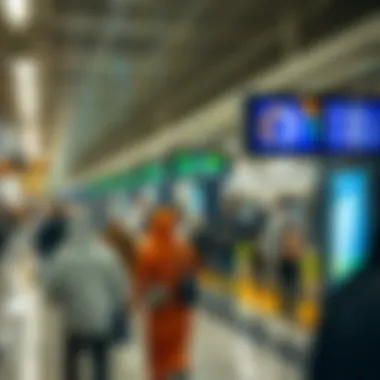
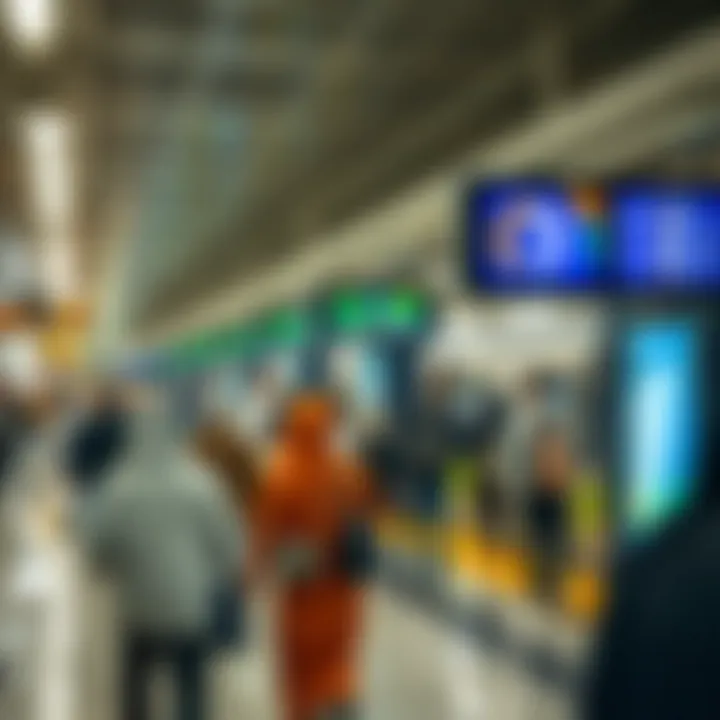
- Metro Stations: Users can recharge at automated machines located throughout the metro stations. These machines accept cash and card payments, ensuring availability.
- Retail Outlets: Many outlets around the city, including supermarkets and convenience stores, allow for NOL card recharges, offering added convenience for users.
- Online Top-Ups: For tech-savvy individuals, there is also the option to recharge the card online through the official RTA app or website, allowing for seamless management of fares.
Each recharge method contributes positively to the overall goal of creating a hassle-free commuting experience. The unique feature of online recharging saves valuable time, particularly during rush hour, while offline options ensure that the system remains accessible to all users.
In summary, the ticketing and payment options for the Dubai Metro not only provide various methods to access the metro system but also play a vital role in enhancing the overall commuter experience. The NOL card, with its assortment of card types and recharge options, is a cornerstone in making the dismissal of worries about fares and travel logistics a reality.
Understanding these systems is not just about convenience; it’s about making the most of what the Dubai Metro has to offer.
Integration with Other Transport Modes
The Dubai Metro is not just a mode of transportation; it's a lifeline connecting various sectors of the city. By integrating seamlessly with other transport modalities, it enhances urban mobility and provides users with a cohesive travel experience. For investors, homeowners, and real estate developers, understanding this integration is critical, as it significantly influences property values and attractiveness of neighborhoods.
Buses and Trams Connections
In Dubai, numerous bus routes crisscross the cityscape, forming a web of connections that funnel passengers to metro stations. Conveniently stationed near metro stops, these bus services help bridge gaps in the transit network, making it possible for commuters to reach their final destinations with ease. For instance, at key metro stations such as Rashidiya and Dubai Mall, the bus interchange facilitates smooth transitions for those jumping from one mode of transport to another.
Moreover, the introduction of trams, particularly in areas like Dubai Marina, further supplements this system. Trams often link directly to metro stations, providing an additional layer of convenience for passengers. Commuters can easily hop on a tram after their train ride, ensuring no lengthy walk or additional fare is needed.
- Benefits of Buses and Trams Connections:
- Reduced travel time for passengers.
- Increased foot traffic to metro stations, enhancing local businesses.
- Lowered carbon footprint by promoting public transport use over individual car journeys.
Ultimately, the bus and tram integration with the metro signifies a forward-thinking approach to urban transport—one that prioritizes efficiency and user experience.
Water Transport Linkages
Dubai's geography, with its stunning coastline and extensive waterways, presents unique opportunities for integrated transport. Water taxis and ferries are integral components of the transit network, connecting areas like Dubai Marina and the Deira waterfront to the metro system. These water transport options add a scenic dimension to commuting while linking urban hubs that are often separated by water.
For instance, passengers can take a water taxi from the bustling Dubai Marina to the Dubai Canal’s metro station. This not only shortens travel time but provides a unique experience of the city’s skyline from the water.
- Considerations for Water Transport Linkages:
- Enhances tourism appeal by offering an alternative, picturesque commuting option.
- Vital for reducing traffic congestion in urban areas.
- Effective for avoiding busy roadways during peak hours.
In sum, the integration of water transport options with the Dubai Metro not only adds variety to the transport experience but also plays a vital role in shaping the future of urban transport in the city. Through these multi-modal connections, Dubai paves the way towards an even more interconnected and efficient urban framework.
Cultural and Economic Impact
The Dubai Metro system, since its inception, has woven itself into the very fabric of the emirate's daily life, serving not only as a means of transportation but also as a catalyst for substantial economic and cultural transformations. The metro's role goes beyond mere convenience; it has become a framework upon which Dubai’s ambitions for modernization and tourism thrive.
Boosting Local Economy
Understanding the economic impact of the Dubai Metro requires a close look at how it acts as a linchpin for both small businesses and large enterprises. Once the metro opened its doors, areas surrounding its stations experienced a noticeable uptick in commercial activities. Retail outlets, restaurants, and other services began flourishing due to improved accessibility. The ease of reaching these venues at various hours has led to a continuous flow of customers.
Some key points include:
- Increased foot traffic: Businesses located near metro stations report a significant rise in visitors compared to before the metro's launch.
- Job creation: The infrastructure necessary for running the metro created thousands of jobs, from construction to ongoing operations and maintenance.
- Attracting investments: The metro has made certain urban areas highly desirable for commercial development, pulling in both local and foreign investors eager to capitalize on improved transport links.
Furthermore, the metro helps reduce traffic congestion, leading to lower transportation costs for businesses and enhancing overall economic productivity. In places like Bur Dubai and Deira, local economies have thrived as entrepreneurs took advantage of this greater connectivity, rapidly expanding their operations and client bases.
Encouraging Tourism
The cultural significance of the Dubai Metro also cannot be understated; it promotes tourism by making key attractions far more accessible. Tourists can navigate the sprawling city with ease, visiting sites such as the Burj Khalifa, The Dubai Mall, and various cultural landmarks connected directly by metro stations. This integration enhances the overall experience for visitors.
Consider these contributions to tourism:
- Convenience for travelers: The affordability and efficiency of the metro allow both tourists and residents to explore Dubai without needing the expense of a car or taxi.
- Promoting cultural landmarks: Stations are strategically located near historical sites, art galleries, and entertainment venues, encouraging tourists to get out and explore more of the city’s rich tapestry of culture.
- Event accessibility: During massive events like the Dubai Shopping Festival or Expo 2020, the metro serves as a primary transportation method, facilitating visitor movement throughout the city with minimal hassle.
The Dubai Metro has not only transformed mobility but also enhanced the city’s status as a global tourist destination, weaving together the past, present, and future of the Emirate.
In a nutshell, the economic and cultural impact of the Dubai Metro stretches well beyond the tracks and trains. It reshapes the city’s landscape, creating a vibrant urban environment ripe for exploration and investment, thereby securing Dubai's place on the global stage.
For more information about the Dubai Metro and its effects on local economics, visit Wikipedia or Britannica.
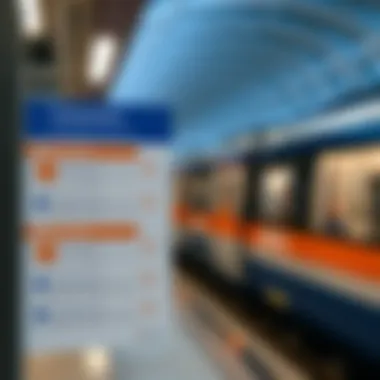
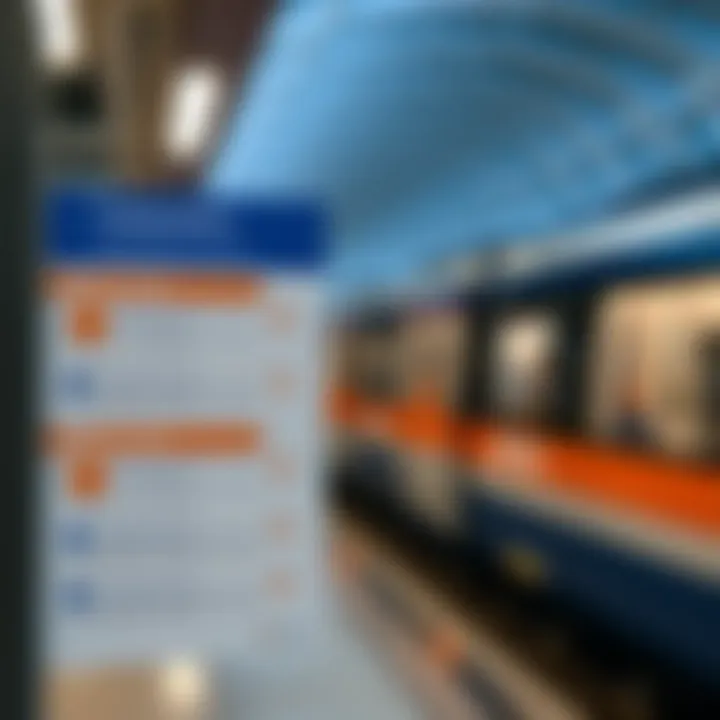
Future Developments
The evolution of the Dubai Metro is not just a reaction to current demands; it is a forward-thinking initiative aimed at enhancing urban mobility for years to come. As the city expands and its population grows, the necessity for a robust and adaptable transportation network becomes crucial. Future developments within the Metro system will play a vital role not only for commuters but also for investors and urban planners who have a stake in Dubai's burgeoning landscape.
Planned Expansions
Dubai Metro’s planned expansions are key to its ambition of becoming a seamless transit network connecting wider areas. Here are crucial highlights:
- Extension of Existing Lines: The Green and Red lines are set to undergo significant extensions to reach burgeoning neighborhoods, enhancing accessibility for residents.
- New Line Implementation: A new metro line is proposed, targeting regions like Dubai South and the Expo 2020 site, substantially boosting connectivity in these rapidly developing locales.
- Integration with Future Projects: The metro’s expansion plans involve connections to forthcoming urban projects, such as Dubai Creek Harbour, ensuring that as the city grows, the transport system keeps pace.
Incorporating these expansions will help alleviate congestion on current routes, offer greater transit options, and ultimately contribute to a more sustainable urban environment.
Technological Innovations
The future of the Dubai Metro also embraces change through technological innovations. This progressive approach is aimed at improving efficiency and commuter experience. Key innovations include:
- Real-Time Updates: Implementation of systems that provide commuters with live updates on train schedules and delays, ensuring a smoother travel experience. Real-time communication reduces uncertainty, which is crucial for retaining commuter trust and satisfaction.
- Smart Ticketing Solutions: Development of more advanced ticketing options, such as mobile payments and contactless systems, reflects a modern preference for convenience. These innovations not only streamline the travel process but also encourage greater use of the metro system.
- Sustainability Initiatives: Innovations are not limited to technology alone; the focus on sustainability includes energy-efficient trains and digital platforms that optimize energy use in real-time.
The commitment to leveraging technology is not just about keeping pace with trends; it's a strategic move towards fostering a world-class public transport system that can withstand the tests of time and growth.
In essence, the Dubai Metro is not standing still. As it adapts and expands, it is shaping the very fabric of urban living, making it imperative for citizens and investors alike to stay abreast of these exciting developments.
User Experience and Challenges
The Dubai Metro system has transformed the public transportation landscape in the city. While many commuters enjoy the sleek, modern stations and punctual trains, user experience remains a complex topic rife with challenges. Understanding this aspect is crucial not only for commuters but also for stakeholders—investors, developers, and policymakers—who must navigate the nuanced feedback received from users. Optimizing the user experience can lead to greater commuter satisfaction, an essential ingredient to successful public transit.
Commuter Feedback
Feedback from commuters is a treasure trove of insight when it comes to identifying strengths and weaknesses within the metro system. Some users appreciate the cleanliness of the trains and stations, such as the Burj Khalifa Station, where the ambience feels almost luxurious. However, not all soars smoothly; many passengers report issues with overcrowding, particularly during rush hours, which detracts from the overall experience.
- Positive Aspects:
- Areas for Improvement:
- Convenient access to key areas across the city
- Electronic displays showing real-time train information
- Safety and cleanliness standards are often highlighted as noteworthy
- Insufficient seating during peak times
- Complicated ticketing experience for first-time users
Survey results indicate that passengers generally feel safe and comfortable using the metro, but congestion and long waiting lines at certain stations remain a significant pain point. It’s essential for the Metro authorities to not only acknowledge this feedback but to also implement actionable changes based on it.
Addressing Congestion
Addressing congestion is a pressing issue that affects user experience directly. The flow of commuters can become quite unwieldy during rush hours, particularly at central hubs like the Dubai Mall Station and Airport Terminal stations. Despite the system's efficiency, heavy usage can lead to discomfort and dissatisfaction among users.
To mitigate these challenges, the metro authorities could consider several strategies:
- Increase Frequency: Adjusting train schedules to run more frequently during peak hours could alleviate crowding.
- Expanded Stations: Developing larger, more capable stations to manage the volume of incoming and outgoing passengers could ease pressure on current facilities.
- Real-Time Updates: Implementing advanced real-time analytics could allow commuters to plan better, reducing the uncertainty that contributes to overcrowding.
Implementing these improvements would require substantial investment and shifts in operational strategy. However, the payoff in terms of enhancing daily experiences and increasing overall transit usage could be significant.
Addressing user experience in public transport is not just about comfort; it’s a crucial factor in urban planning and economic sustainability.
In sum, understanding the user experience and directly responding to challenges like congestion can bolster the efficiency and reputation of the Dubai Metro system, fostering an environment that is not only user-friendly but also attractive to potential investors and developers.
Ending
The conclusion of this guide encapsulates the essence of the Dubai Metro system and its invaluable role in shaping urban mobility. It’s not just a transport solution; it’s a lifeline for the city's residents and visitors alike. The comprehensive details provided throughout this article exhibit how the metro has redefined accessibility in Dubai, significantly easing commutes across its sprawling landscape.
Summarizing the Metro’s Role
The Dubai Metro serves multiple crucial functions within the public transport framework. First and foremost, its efficient connectivity reduces traffic congestion, a common woe in rapidly developing urban areas. The metro is a reliable alternative to driving, unwanted delays, and parking troubles. Moreover, it plays a pivotal role in enhancing the city’s environmental sustainability by promoting public transport over individual car use.
Furthermore, the metro system acts as a catalyst for economic growth. Key commercial areas and landmarks adjacent to metro stations have flourished, benefiting from increased foot traffic. Notably, the proximity to the Burj Khalifa and Dubai Mall has turned these stations into strategic hubs for business and tourism. Through the lens of mobility equality, the metro system expands access to diverse populations, addressing essential needs for various social segments.
Looking Ahead
As we gaze into the future of the Dubai Metro, the potential for growth and innovation appears limitless. Planned expansions promise to integrate more neighborhoods, thus heightening connectivity. Additionally, the introduction of AI and automated systems is likely to render the experience more intuitive and responsive to commuter needs.
Moreover, technological advancements may lead to enhancements in user experience through better real-time updates and efficient ticketing processes. As Dubai continues to evolve, the metro's influence will undoubtedly grow, reflecting the wide-ranging ambitions of a city that is always in motion. These expansions and innovations will not only cater to existing demand but will also anticipate future growth, ensuring the metro remains at the forefront of urban transit solutions.
In essence, the Dubai Metro is a testament to the city's commitment to progress, sustainability, and innovation. Its ongoing development is something that caters not just to today’s needs but looks firmly into the horizon of tomorrow, promising a transport system that is as dynamic and vibrant as the city it serves.







